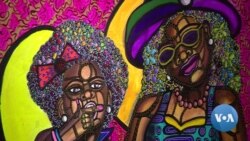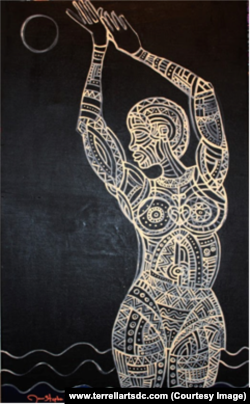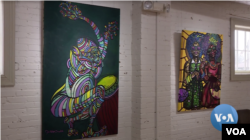Artist Zsudayka Nzinga Terrell vividly recalls the day in elementary school when an assignment about family history made the impossibility of answering the questions Who am I? and Where did I come from? clear.
“These white kids were able to get out and talk about hundreds of years of their background. And it was me and one of the black kids in the class who could go back to a plantation in Virginia and that’s it.”
“My people were brought here on a bottom of a ship,” she says. “They were sold and they were re-named. My dad’s side of the family took the last name of the job they had, which is Butler. My mom’s side of the family took the last name of the plantation that owned them. So I’m not just Nigerian now, I’m not just Ghanaian. I’m a combination of things.”
Today, she and her husband, artist James Terrell, explore that identity in their work. Their new exhibit of acrylic paintings at the Center for the Arts in Manassas, Virginia, is called “Born at the Bottom of the Ship” and reflects their quest.
New culture, new tribe
Over the generations, Africans became African Americans with a new culture, and Nzinga Terrell incorporates various elements of that in her art.
“You’ll see a lot of things that remind people of the African print and African textiles. But you’ll also see things that are reminiscent of the American culture and American print and textile,” she says.
An example is “Hope and Grace,” a painting of two women wearing colorful dresses with distinctive African patterns. “They have these big afros,” she adds. “They have different skin tones as well as different hair texture. It could be in 1960; it could be in 2018. I feel like there is an embodiment in them of all of the different cultures. I love the strength of them and their poses. They both look very sure of themselves. Both are very unapologetically black.”
James Terrell’s style is more abstract. Mami Wata, the first piece visitors see in the new exhibit, shows a woman rising from the ocean, created with white lines on a black background.
“Mami Wata is the goddess of the sea," Terrell says. "The line work, I tried to make it indicative of the tribal aspect, but also shown as a dark time, dark period. There is no light going through it; there’s not a lot of color seen, as opposed to the other ones. So, it’s just showing the time of the slaves being brought to America.”
But the artist says he also likes to play with color. “There was a color theorist named Josef Albers who was really into a color theory that had layers of colors and how to lay colors next to each other. So, growing up in a church that was into stained glass windows and how light comes through the windows, how colors vibrate, how they layered against each other. Then, the line in the middle, which separates the stain glass windows.”
Terrell’s works reflect how he sees himself as an African American.
“Trying to be uplifting, uplifting poses and not bowed down,” he says. The figures he paints "are standing firm, standing strong. The lines are symbolizing the fact that people say that our race has been broken, but I say that we’ve been put back together. And we’re stronger as people. The different colors represent the fact that we were coming from different backgrounds, we all come together, and we’re still together to form a particular person or a particular feeling.”
As a husband and wife team, togetherness seems to impact their work in a positive way. “I’d say it’s a healthy competition,” Terrell says. “We give each other good advice. We can talk in terms of, ‘Well, should I put this color here or should I put this line here, what you think?'”
Delightful and inspirational
Jordan Exum, gallery director at the Center for the Arts, says exhibit goers relate to artists’ identity exploration.
“I’ve found that people enjoy this exhibit; it’s a diverse group of people,” she notes. “It’s not just one culture, ethnicity that’s impacted by the message of the exhibit, which is exploring who African Americans are today. A lot of us in America, immigration is part of a lot of families’ histories and stories. So, I do think it’s a relevant theme. It’s a universal theme. I don’t think it only relates to the African American community.”
That was true for photographer Theresa Coates Ellis, who says she found “Born at the Bottom of the Ship” both intellectually and visually engaging.
“As I walked in the main door, it was just an ‘ah!’ experience,” she said, trying to describe how surprised she felt. “But when the lights were turned to blue, it was a whole different experience. Everything popped. You see colors you didn’t even really recognize during the actual natural lighting.”
Another visitor, Kevin Seiger-Cottoms, saw himself in these works.
“When I first walked in, the colors and the shapes hit me first because I’m a mathematician and I love the geometry of the shapes and how they fit together,” he says. “Many things in this country are drawn from a European perspective, which I have nothing against, but it’s nice to be able to walk in and see my aunt, my cousin, my mom, my dad -- to see different people that I relate to."
The artists hope to take their exhibit on tour across America and around the world.













